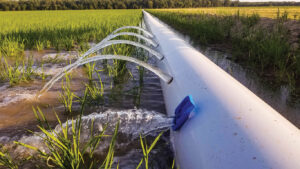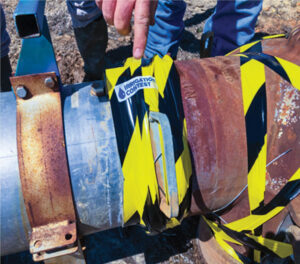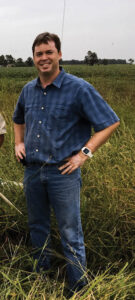Most farmers are familiar with contests in which participants try to achieve the maximum yield of a crop from a given field. Fewer would be familiar with a contest in which participants’ total crop yield is divided by the amount of water they use—thus measuring their water use efficiency. That’s the kind of contest that Dr. Chris Henry and his colleagues at the University of Arkansas sponsored for the first time in 2018. Building on the success of a 5-year on-farm demonstration program, they developed the Arkansas Irrigation Yield Contest to harness farmers’ ingenuity and competitive instincts in order to increase water use efficiency.
In this interview with Irrigation Leader Managing Editor Joshua Dill, Dr. Henry discusses the genesis of the Arkansas Irrigation Yield Contest, its results, and the lessons learned from the contest’s first year of operation.

Joshua Dill: Please tell us about your background and how you ended up in your current position.
Chris Henry: I grew up on a farm in Kansas and obtained my bachelor’s and master’s degrees in biological and agricultural engineering at Kansas State University. Then I went to the University of Nebraska and worked there as an extension engineer. While I was there, I spent 10 months in Australia as a Fulbright scholar. I worked on my PhD while I was a full-time employee and finished in 2011. Then I came to Arkansas and have been here for 6 years. I’m an associate professor and water management engineer with the University of Arkansas at the Rice Research and Extension Center.
Joshua Dill: How did the idea for the irrigation yield contest emerge?
Chris Henry: My colleague in Mississippi, Dr. Jason Krutz, and I had started programs where we demonstrated irrigation water management (IWM) practices on farms using a paired-field comparison. These tracked two fields: a field managed with IWM practices and a control field managed by a farmer. We were able to document that IWM practices could achieve a reduction in water use of about 24–27 percent—about 21⁄2 acre-inches of water savings.
However, paired-field comparisons had their downsides. One of the challenges was that during the course of the demonstration itself, the farmers would begin to schedule irrigation on the control field using techniques and technologies they observed us using on the IWM field, like soil-moisture sensors. In addition, the motivation to do a paired comparison is not always strong with farmers, because they see it as a test. Even if we are able to demonstrate that our techniques result in significant water savings or a big yield improvement, it may not be enough to make them consider making a change. There is a perception that implementing IWM may cut into profits because of yield drag or because of additional equipment costs.
We wanted to find a program that would reward and recognize farmers for excelling in the implementation of IWM. The contest approach provides a mechanism to recognize hard work and ingenuity. We hoped that it would also tap into farmers’ competitive instinct. We also wanted to establish a reward for being the best out there—a big prize. So we went out and accumulated about $20,000 in prizes for each of our three categories. The irrigation industry really stepped up to support this effort.
Joshua Dill: How is this contest different from other yield contests that farmers might be familiar with?
Chris Henry: Commodity-based yield contests are popular. There is the National Corn Growers Association’s yield contest; the California Rice Yield Contest; and, in Arkansas, the Go for the Green Soybean Yield Contest. These operate on the basis of maximum yield—maximum bushels per acre. The growers enter a field and are required to harvest a portion of it, usually between 11/4 and 5 acres, with a supervisor present to witness the yield.
We used a similar concept, but in our contest, the winner is not the person with the greatest overall yield, but the person with

the greatest yield per amount of water on the field—the person who gets the most crop per drop. We track rain using precipitation models and measure the amount of irrigation water that is applied to the field, and then calculate the farmers’ water use efficiency by dividing the yield by the amount of water on the field. The farmer with the best water use efficiency wins. There is a winner for each of the three commodities that have supported the contest: corn, rice, and soybeans.
Participants must have a flow meter that we know is accurate. Arkansas is a mainly surface-irrigated state, so we use portable propeller meters manufactured by McCrometer in Hemet, California. We have come up with a tamper-proof method of attaching and sealing the flow meters and universal hydrants to the alfalfa valve, so we can guarantee that they measure all the irrigation water applied. We also spent a lot of time writing rules to make sure that we could ensure the accuracy and validity of our measurements. I have great program associates, Greg Simpson and Dustin Pickelmann, who make sure that the contest, as well as our research and extension programs, are well implemented. They took care of most of the meter sealing, the setup with IWM tools, and the yield checks. Almost every contestant got help from their local county extension agent or an NRCS technician, so there was considerable involvement at the local level. The contestants and supervisors all had the opportunity to learn and experiment together.
Joshua Dill: This was your first year. What were the biggest challenges you faced?
Chris Henry: We had a lot of challenges. One challenge was making sure we could guarantee that the meters would not be tampered with. The second challenge was deciding how to handle rainfall. We use National Weather Service models to predict rainfall rather than relying on onsite rain gauges.
Also, we needed a substantial prize. We thought we needed at least $10,000. We had strong support from the Arkansas Corn and Grain Sorghum Promotion Board and the Arkansas Soybean Promotion Board; they donated $10,000 each. The industry strongly supported the effort as well. The first company to commit to supporting the contest was McCrometer, which donated portable flow meters for each winner. Ricetech donated a seed tote valued at over $10,000 for the prize of the rice contest. We also received commitments from P&R Surge and Triad Fastener for surge valves and controllers for each of the winners. Irrometer donated sensors, hardware, and cash for each winner. Delta Plastics donated cash. Trellis donated a sensor array, a wireless node, and a gateway for each winner. In total, each winner will receive over $20,000 in cash and products.
Joshua Dill: Did you see the participants taking different approaches?
Chris Henry: Yes. I think the water management element was harder than some participants expected. The farmers tried a variety of approaches, including some we didn’t even think about. We expected many to use computerized hole selection, surge irrigation, and soil-moisture sensors. Many of them did; some of them didn’t. In the rice contest, most farmers used multiple-inlet rice irrigation and alternate wetting and drying. About half the fields were furrow irrigated; the other half used alternate wetting and drying. Furrow irrigation is a production system for rice that has become more popular in recent years. It was interesting that people used the furrow-irrigated rice- production system rather than the conventional flood-levee system to try to win the contest. There was no real difference between the results of the two systems, which is surprising because less than 10 percent of the acres of rice in Arkansas are furrow irrigated.

The soybean grower who won the contest yielded over 100 bushels an acre, which is a pretty impressive yield for soybeans under any circumstances. That was a surprise to us: All the yields were respectable, in line with what a normal yield contest with unlimited water would produce. For example, Arkansas’s Go for the Green Soybean Yield Contest has 24 winners, one for each of 24 categories dependent on tillage system and region; only one of those winners had a higher yield than our soybean contest winner did.
Nobody in our contest intentionally severely deficit irrigated, which is one of the things we were concerned about. Our rules include a minimum yield, which is intended to eliminate contestants who severely deficit irrigate. The goal of the contest is to have a nearly fully irrigated contest crop.
Joshua Dill: What were the biggest lessons learned about irrigation methods?
Chris Henry: I was amazed at how far some of the contestants took the tools we have provided. The corn contest winner used my mobile app to interpret sensor readings. I helped him at the end with terminating the crop. He had just enough water to finish out the crop, thanks to his usage of the sensors and the app to check the growth stage. It was really nice to see him win and to help him make that call at the end.
You’ve got to have a little luck and skill. If you get a lot of rain, that’s probably going to throw you out, because your total water numbers are going to be higher, but if you’re really dry, you have to irrigate more. We know irrigation is not as good as natural rainfall. Everything else has to go right during the season for you to win, which makes it interesting. The highest yields didn’t necessarily win the contest. You had to have both high yield and low water use.
Joshua Dill: What can you say about the advantages of using a contest format as a method of educating and promoting innovation?
Chris Henry: We’re going to present the winners with their prizes at the Arkansas Soil and Water Conservation Conference, a well-attended yearly conference at the end of January, and the contestants will be able to talk about how they did it. That’s going to be a really great way for others to learn. Anyone who entered the contest is a winner at the end of the day. The experience of carefully managing water on one field may show them that it is not as hard as they thought. It may also be interesting to compare the approach they took to the contest to their normal way of doing things. Even the farmers who didn’t win may find that their yields and their water use efficiency were better than they expected.
The contest recognizes farmers for their hard work and demonstrates what they can accomplish. Normally, when we preach water conservation, it is just another obligation for farmers to meet and they do not gain any real recognition for it. It is much different to be able to say, “You saved an amazing amount of water; here is $20,000.”
Joshua Dill: By how much did you find that farmers were able to reduce their water use?
Chris Henry: In the rice contest, the average water use of participants in the contest was about 31 acre-inches per acre. That’s near the average of 32 acre-inches per acre for a rice crop in Arkansas. The winner was able to do it on about 16 acre-inches—about half of the average use.
Joshua Dill: What can you tell us about the long-term goals of this project?

Chris Henry: We’re just getting started. Contestants from last year have already started planning their entry for this year. I expect more entrants this year, although the number may be limited somewhat because of the requirement of a portable flow meter.
Joshua Dill: Do you know of other organizations or people who have been inspired to look into doing a similar contest?
Chris Henry: Not yet. Daran Rudnick, Matt Stockton, and Chuck Burr created the Testing Ag Performance Solutions (TAPS) program in Nebraska, which looks at overall profitability. They have a program in which groups make production-related decisions using a variable rate irrigation center pivot and then make all the marketing- related decisions associated with selling their crop, and they recognize the most profitable group. We’ve been comparing notes with them over the last year.
Chris Henry is an associate professor and water management engineer with the University of Arkansas at the
Rice Research and Extension Center. For more information about the Arkansas Irrigation Yield Contest, visit www.uaex.edu/irrigation or contactDr. Henry directly at cghenry@uark.edu.
